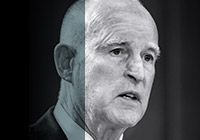As time runs out on his fourth and final term as California governor, Jerry Brown has been devoting much of his time to reaching a long-held goal — redoing the state’s important but troubled north-south water system.
California WaterFix, as the latest iteration is known, seeks to improve the quality and reliability of water supplied via the Sacramento-San Joaquin Delta to Central Valley farmlands and 25 million Californians. It also promises to mitigate at least some of the many ecological problems in the
bucolic delta, where years of water diversions have introduced non-native species and endangered native fish. Rising sea levels driven by climate change threaten to overwhelm the Delta with saltwater, and the possibility of a major earthquake could destroy its 50-year-old levees.
One proposed solution is to build up to two four-story-tall tunnels, some 150 feet beneath the Delta, which would carry water from the Sacramento River for about 35 miles to connect with state and federal water project canals.
WaterFix would augment the California Water Project, spearheaded by then-Gov. Pat Brown, Jerry Brown’s father, in 1960. It also recalls Jerry Brown’s earlier attempt to re-plumb the Delta during his first tenure as governor, from 1975 to 1983. The Peripheral Canal proposed a large bypass around the Delta. Voters rejected it in 1982.
Now the enormous size of the proposed tunneling — the biggest water supply project in the state in decades — has brought comparisons with Boston’s underground highway “Big Dig” and the undersea “Chunnel” that links England and France.
“It’s a fairly big deal,” said Jay Lund, director of the Center for Watershed Services at UC Davis. And an even bigger deal in Southern California, which, he noted, gets up to one-third of its water supply from the Delta.
“The problems of the Delta are manifold, with land subsidence, quake vulnerability, endangered species and ecosystem problems, plus the sea level rise. People are rightly concerned about this,” Lund said.
The tunnel project would “make quite a few of the water supply problems easier and may help some of the environmental problems,” Lund said.
But, like earlier proposals for the Delta water system, the tunnel plan has encountered obstacles. Environmental groups, including the Sierra Club and the Natural Resources Defense Council, are adamantly opposed; some others have yet to decide, perhaps weighing the prospects for the project’s coming to fruition before taking a stand.
Delta interests, including growers who feel their generations-old enterprises would be threatened, also are lined up against the project.
The $17-billion price tag has prompted the agencies that back the project — including the Metropolitan Water District in Southern California and the huge agricultural interests in the Central Valley — to reconsider paying for it.
A recent state auditor’s report found the project lacked sufficient economic and financial analyses, providing more fodder for its opponents.
Meanwhile, the main candidates to succeed Brown are either opposed or keeping the issue at arm’s length.
And this is not a matter that has caught the attention of most Californians.
“What it doesn’t have is a groundswell of support,” said Jeffrey Mount, a senior policy analyst at the Public Policy Institute of California, who, as a professor at UC Davis, sounded an alarm about the vulnerability of the Delta’s water supply system in a 2005 analysis.
Timing is crucial now because “it’s Jerry Brown’s last year in office,” Mount said, “and nothing like this happens without leadership from the top.”
All this has left the Brown administration to aggressively lobby the MWD and others to pick up the tab. The administration also has pushed to complete four major permitting and environmental requirements and expects to have the seven remaining in hand by the end of the year,
according to a spokeswoman for the California Natural Resources Agency.
Even if financing and permitting hurdles are cleared before Brown leaves office, the project won’t be completed for at least 15 years, the estimated time needed for land acquisition and construction. And that’s not accounting for expected lawsuits and resulting delays.
“Someone will litigate, no matter what,” said Lund.
If the project gets derailed at some point, don’t look for a quick or inexpensive alternative, said Mount, who claims he is “agnostic” about whether WaterFix should go through.
“If you want to maintain a good quality, reliable water supply from the Delta for the 25 million people who depend on it, then you have to build this facility,” Mount said. “Otherwise, the forces arrayed against the Delta are going to overwhelm it.”
But whether protecting the water supply is worth the expense and the cost to the environment “is a policy question,” Mount said, one left to elected officials — or voters.
























